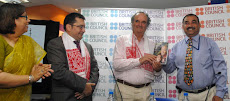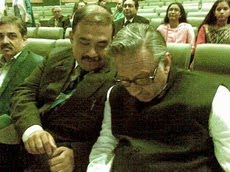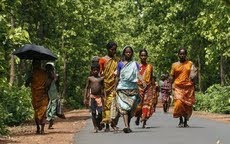 But put them altogether and Mamata has been able to do what neither Deshbandhu Chittaranjan Das or Netaji Subhas Chandra Bose, the two great heroes of freedom struggle from Bengal, have been able to do.
But put them altogether and Mamata has been able to do what neither Deshbandhu Chittaranjan Das or Netaji Subhas Chandra Bose, the two great heroes of freedom struggle from Bengal, have been able to do.Both Deshbandhu and Netaji left the Congress after prolonged tussle with the central Congress leadership and came up with their own parties - Deshbandhu with the Swarajya party and Subhas Bose with the Forward Bloc. But despite their enormous stature and huge prestige as great inspiring leaders, neither Deshbandhu nor Netaji could break and undermine the Congress in Bengal and reduce it to a second fiddle of their own parties. The Congress remained ever so much more powerful than the Swarajya or the Forward Bloc. Even Pranab Mukherjee created a regional party, Rastriya Congress in the mid-1980s, after his clash with Rajiv Gandhi. That did not work, though when Pranab Mukherjee went into revolt, he had been practically number two in the Union cabinet under Indira Gandhi. He failed to make any impact and returned to the Congress. His performance as a minister in the present UPA government has been superb - his energy and political sense, his experience and capacity to handle huge workloads makes him an obvious choice for being Prime Minister, But alas, he has to remain happy by recommending Rahul Gandhi as the next Prime Minister of the country.

 Mamata has made Mohammed come to the mountain, as goes the English proverb. Within a decade of her breaking away from the Congress, she has eclipsed the Congress to third position in Bengal. Now she is challenging the CPI(M) for first position in West Bengal politics. She has emerged as the main opposition party in Bengal. In 2004 parliament election, her party got just one seat. Her own in South Kolkata. The Congress got six. The Left won 35 seats. The Left eclipsed her in 2006 assembly elections. But in the last three years, courtesy the agitations or Singur and Nandigram, Mamata has changed all equations. So the Congress is now forced into a political alliance in which they are junior partners by compulsion. They are fighting 14 parliament seats, Mamata is contesting 28.
Mamata has made Mohammed come to the mountain, as goes the English proverb. Within a decade of her breaking away from the Congress, she has eclipsed the Congress to third position in Bengal. Now she is challenging the CPI(M) for first position in West Bengal politics. She has emerged as the main opposition party in Bengal. In 2004 parliament election, her party got just one seat. Her own in South Kolkata. The Congress got six. The Left won 35 seats. The Left eclipsed her in 2006 assembly elections. But in the last three years, courtesy the agitations or Singur and Nandigram, Mamata has changed all equations. So the Congress is now forced into a political alliance in which they are junior partners by compulsion. They are fighting 14 parliament seats, Mamata is contesting 28.This is her first victory. A major one in historical turn. Turning the Congress into a party of lesser importance than her Trinamul party. Some thing that Deshbandhu and Netaji failed to do. The Bengal Congress has always produced powerful leaders capable of ruling and agitating. It has produced Chittaranjan Das and Subhas Bose and Sarat Bose, it has produced Bidhan Roy and Atulya Ghosh, it has produced the Sidhartha Shankars and the Pranab Mukherjees.
 Some great freedom struggle leaders, brave and self sacrificing, some great state builders like Bidhan Roy and party builders like Atulya Ghosh. But it has not produced a leader who is capable of teaching the Congress central leadership a lesson. Mamata Banerjee shares the long Bengal Congress tradition of challenging the Delhi leadership, the AICC's style of functioning, of dominating the state leadership. But she is the only one who has forced the Delhi Congress to come to her begging for an alliance and accepting a junior position in the alliance.
Some great freedom struggle leaders, brave and self sacrificing, some great state builders like Bidhan Roy and party builders like Atulya Ghosh. But it has not produced a leader who is capable of teaching the Congress central leadership a lesson. Mamata Banerjee shares the long Bengal Congress tradition of challenging the Delhi leadership, the AICC's style of functioning, of dominating the state leadership. But she is the only one who has forced the Delhi Congress to come to her begging for an alliance and accepting a junior position in the alliance.It is not only her fight against the CPI(M) led Left government that makes Mamata so popular in Bengal today. Those who hate the Left - and the anti-Left vote in Bengal has never gone below 40 percent though it is divided - surely hail Mamata and support it. But many also support her because she held her own against the Congress. Though Bengal has no separatist tradition, like Assam or the Northeast, the people in the state like leaders who can stand up to Delhi. That Mamata could do that and tame the great Congress makes her doubly popular with the masses in West Bengal. If her party wins even one-third of the parliament seats in Bengal this time, it will becom siderable achievement. Going by the popular mood, she may do better than that.
(Subir Bhaumik is the BBC's East India Correspondent)
Post your Feedback on this column at : mail@bengalnewz.com OR bn.desk@gmail.com







